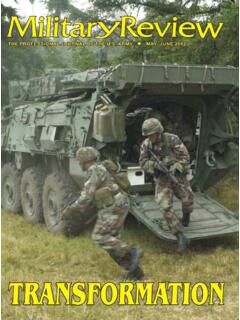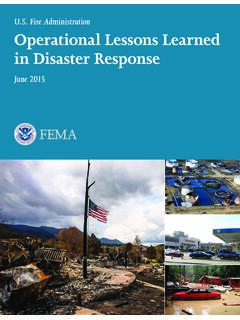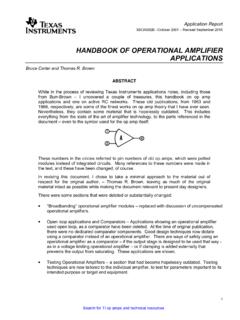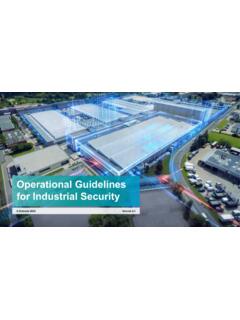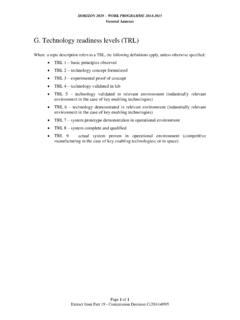Transcription of The Value of Science Is in the ... - Army University Press
1 23 MILITARY REVIEW January-February 2016 The Value of Science Is in the ForesightNew Challenges Demand Rethinking the Forms and Methods of Carrying out Combat OperationsGeneral of the Army Valery Gerasimov, Chief of the General Staff of the Russian Federation Armed ForcesRussian President Vladimir Putin and General of the Army Valery Gerasimov, chief of the General Staff of the Russian Federation Armed Forces, observe military exercises 17 July 2013 near Baikal Lake in Russia. The military maneuvers were the largest since Soviet times, involving about 160,000 troops and 5,000 tanks across Siberia and the far eastern region of Russia.(AP Photo by RIA Novosti, Alexei Nikolsky, of the Russian Presidential Press Service)January-February 2016 MILITARY REVIEW24 Originally published in Military-Industrial Kurier, 27 February Translated from Russian 21 June 2014 by Robert Coalson, editor, Central News, Radio Free Europe/Radio article is provided to acquaint our readers with the perspectives of senior Russian military leaders on the subject of future war and should not be construed as an effort to promote their the twenty-first century we have seen a tendency toward blurring the lines between the states of war and peace.
2 Wars are no longer declared and, having begun, proceed according to an unfamiliar experience of military conflicts including those connected with the so-called color revolutions in North Africa and the Middle East confirms that a perfectly thriving state can, in a matter of months and even days, be trans-formed into an arena of fierce armed conflict, become a victim of foreign intervention, and sink into a web of chaos, humanitari-an catastrophe, and civil Lessons of the Arab SpringOf course, it would be easiest of all to say that the events of the Arab Spring are not war, and so there are no lessons for us military men to learn. But maybe the opposite is true that precisely these events are typical of warfare in the twenty-first terms of the scale of the casualties and destruction, the catastrophic social, economic, and political conse-quences, such new-type conflicts are comparable with the consequences of any real very rules of war have changed.
3 The role of nonmilitary means of achieving political and strategic goals has grown, and, in many cases, they have exceed-ed the power of force of weapons in their effectiveness [see figure 1].The focus of applied methods of conflict has altered in the direction of the broad use of political, economic, informational, humanitarian, and other nonmilitary measures applied in coordination with the protest potential of the this is supplemented by military means of a concealed character, including carrying out actions of informational conflict and the actions of special oper-ations forces. The open use of forces often under the guise of peacekeeping and crisis regulation is resorted to only at a certain stage, primarily for the achievement of final success in the this proceed logical questions: What is mod-ern war? What should the army be prepared for?
4 How should it be armed? Only after answering these questions can we determine the directions of the construction and development of the armed forces over the long term. To do this, it is essential to have a clear understanding of the forms and methods of the application of days, together with traditional devices, nonstan-dard ones are being developed. The role of mobile, mixed-type groups of forces, acting in a single intelligence-informa-tion space because of the use of the new possibilities of com-mand-and-control systems, has been strengthened. Military actions are becoming more dynamic, active, and fruitful. Tactical and operational pauses that the enemy could exploit are disappearing. New information technologies have enabled significant reductions in the spatial, temporal, and informational gaps between forces and control organs.
5 Frontal engagements of large forma-tions of forces at the strategic and operational level are gradually becoming a thing of the past. Long-distance, contactless actions against the enemy are becoming the main means of achieving combat and operational goals. The defeat of the enemy s objects [objectives] is con-ducted throughout the entire depth of his territory. The differences between strategic, operational , and tactical levels, as well as between offensive and defensive opera-tions, are being erased. The application of high-precision weaponry is taking on a mass character. Weapons based The very rules of war have changed. The role of nonmilitary means of achieving political and strategic goals has grown, and, in many cases, they have exceeded the power of force of weapons in their REVIEW January-February 2016 FORESIGHTon new physical principles and automatized systems are being actively incorporated into military actions have come into widespread use, enabling the nullification of an enemy s advantages in armed conflict.
6 Among such actions are the use of spe-cial operations forces and internal opposition to create a permanently operating front through the entire territory of the enemy state, as well as informational actions, de-vices, and means that are constantly being ongoing changes are reflected in the doctrinal views of the world s leading states and are being used in military in 1991, during Operation Desert Storm in Iraq, the military realized the concept of global sweep [global reach], global power and air-ground op-erations. In 2003 during Operation Iraqi Freedom, mil-itary operations were conducted in accordance with the so-called Single Perspective 2020 [ Joint Vision 2020].Now, the concepts of global strike and global missile defense have been worked out, which foresee the defeat of enemy objects [objectives] and forces in a matter of hours from almost any point on the globe, while at the same time ensuring the prevention of unacceptable harm from an enemy counterstrike.
7 The United States is also enacting the principles of the doctrine of global integra-tion of operations aimed at creating in a very short time highly mobile, mixed-type groups of recent conflicts, new means of conducting military operations have appeared that cannot be considered purely military. An example of this is the operation in Libya, where a no-fly zone was created, a sea blockade imposed, and private military contrac-tors were widely used in close interaction with armed formations of the must acknowledge that, while we understand the essence of traditional military actions carried out by regular armed forces, we have only a superficial under-standing of asymmetrical forms and means. In this con-nection, the importance of military Science , which must create a comprehensive theory of such actions, is grow-ing. The work and research of the Academy of Military sciences can help with in the Character of WarfareAchievement of Political Goals e use of military forcesTraditional forms and methods e use of political, diplomatic, economic and other nonmilitary measures in combi-nation with the use of military forcesNew forms and methods-initiation of military operations a er strategic deployment-frontal clash of large groupings of line-units, the basis of which consists of ground troops-the destruction of personnel and weaponry, and the conse-quent possession of lines and areas with the goal of the seizure of territories-destruction of the enemy, destruction of the economic poten-tial and possession of his territories-the conduct of combat operations on the ground.
8 In the air and at sea-the command-and-control of groupings of line units (forces) within a framework of a strictly organized hierarchical struc-ture of command-and-control agencies-initiations of military operations by groupings of line-units (forces) in peacetime-highly maneuverable, noncontact combat operations of inter-branch groupings of line-units-reduction of the military-economic potential of the state by the destruction of critically important facilities of his military and civilian infrastructure in a short time-the mass use of high-precision weaponry, the large-scale use of special operations forces, as well as robotic systems and weapons based on new physical principles and the participa-tion of a civil-military component in combat operations-simultaneous e ects on line-units and enemy facilities through-out the entire depth of his territories-warfare simultaneously in all physical environments and the information space-the use of asymmetric and indirect operations-command-and-control of forces and assets in a uni ed information spaceFigure 1.
9 Graphic from Gerasimov article in Voyenno-Promyshlennyy Kurier, 26 February 2013, translated by Charles BartlesJanuary-February 2016 MILITARY REVIEW26 The Tasks of Military ScienceIn a discussion of the forms and means of military conflict, we must not forget about our own experi-ence. I mean the use of partisan units during the Great Patriotic War and the fight against irregular formations in Afghanistan and the North would emphasize that during the Afghanistan War, specific forms and means of conducting military oper-ations were worked out. At their heart lay speed, quick movements, the smart use of tactical paratroops [para-troopers] and encircling forces, which all together en-abled the interruption of the enemy s plans and brought him significant factor influencing the essence of modern means of armed conflict is the use of modern auto-mated complexes of military equipment and research in the area of artificial intelligence.
10 While today we have flying drones, tomorrow s battlefields will be filled with walking, crawling, jumping, and flying ro-bots. In the near future it is possible a fully robotized unit will be created, capable of independently con-ducting military shall we fight under such conditions? What forms and means should be used against a robotized en-emy? What sort of robots do we need and how can they be developed? Already today our military minds must be thinking about these most important set of problems, requiring intense attention, is connected with perfecting the forms and means of applying groups of forces. It is necessary to rethink the content of the strategic activities of the Armed Forces of the Russian Federation. Already now questions are arising: Is such a number of strategic op-erations necessary? Which ones and how many of them will we need in the future?






